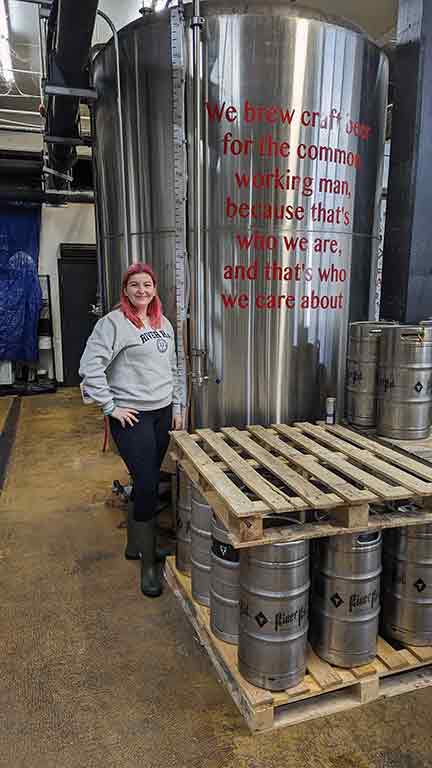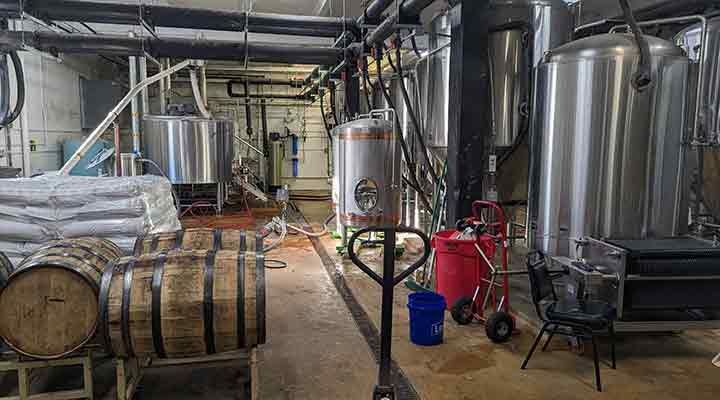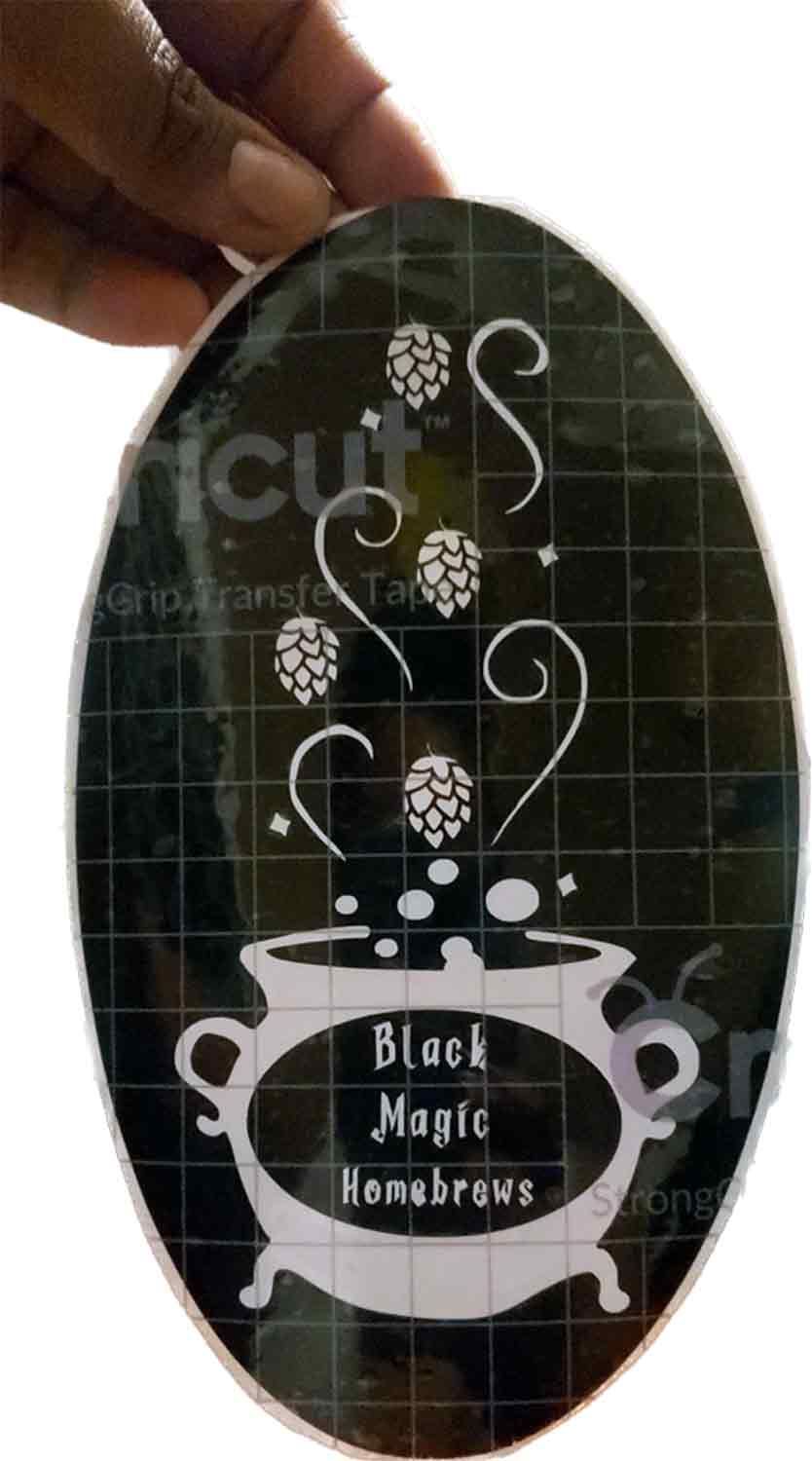Assistant brewer Katie Knight helps brew and can River Rat’s craft beers. River Rat’s entire production, from mash to canning, is completed in-house at its Shop Road location. (Photo by Noah Hale)
Do something you love and you’ll never work a day in your life, as the old saying goes. Ask a craft brewer about how they got started, and they’re likely to mention a homebrewing hobby.
You would also notice the brewer you’re talking to is likely male.
The national craft beer industry as a whole was worth $26.8 billion in 2021, according to the Brewers Association. But in 2019, only 7.5% of all brewers in the United States were women.
“We certainly do need more diversity and to encourage more women to come into the brewing space,” said Katie Knight, an assistant brewer at Columbia’s River Rat Brewery.
The numbers rise and fall, but Knight right now is one of only several dozen women employed on brew teams around the state.
Industry and advocacy groups are working to change that.
River Rat’s up-and-comer
Knight worked in the service industry right out of high school. She started with a local mom-and-pop shop before eventually getting her first job at the now-closed Flying Saucer in the Vista, which exposed her to the craft beer industry.
“They taught me way too much about beer for an 18-year-old to know,” Knight said with a chuckle.
Knight later landed at River Rat on Shop Road, working as an assistant brewer. She completes some of the more manual tasks, such as adding ingredients to the brew, getting equipment connected or canning the beer the brewery produces.
“I’m able to do pretty much all of the work that comes with an average brew day,” Knight said.
Knight still works some shifts behind the bar, serving customers. She’ll have more of a hand eventually in creating a recipe to call her own in River Rat’s taproom. She already lends a hand with with some of the finer details of a recipe.
“I love brewing,” Knight said. “Even when I’m not at work, I’m homebrewing or reading different things, studying and just building up everything I can possibly learn, because I think it’s just so fascinating and interesting. I truly, truly love what I do.”
Habitap’s brew witch
Candice Campbell’s path to becoming the head brewer at a Habitap in Greenville has been a stranger one.
“It doesn’t seem real sometimes,” she said, laughing.
Going from disliking beer, to serving on the board of directors for the South Carolina Brewers guild, it’s enough change to make someone’s head spin.
Campbell, who homebrewed for 10 to 11 years, works in education, but she’s also the head brewer at Habitap, starting when the business began brewing its own product in December 2021. Habitap knew her because she used to bring her homebrews into the taproom for feedback.
“I didn’t realize that they wanted me to brew until I had a second conversation with them,” Campbell said. “They’re like, ‘Oh, no. We want you to be the brewer.’”
The origin of ‘brew witches’
When discussing the history of brewing beer, it can’t be ignored that beer brewing was traditionally a woman’s task, Campbell said.
Some women, known as ale-wives, sold beer. Then men began brewing beer for sale. Later, they built larger brewing operations and forced women out of business, sometimes by stealth.
“They rumored that the beer was poisoned,” Campbell said. “So, these women that are wearing pointy hats evolved into nasty demonic creatures who were pouring beer.”
The caricature of witches is partially inspired by lies told about women who brewed beer in the Middle Ages.
She and a friend call themselves ‘brew witches,’” Campbell said.
“I was brewing one time, and I was on the phone (with another friend) on FaceTime, and he was like, ‘Why do you look like you’re stirring a cauldron?’” she said. “And I was like, ‘Because I am. This is what I do. This is my witch broom.’”
Campbell fully adopted the moniker when she named her homebrews “Black Magic Home Brews.”
“Black magic is witchy,” Campbell said. “Black magic is also something cultural.”
“It kind of just worked as like the double entendre …,” she said. “I had a little cauldron logo and everything.”
Tackling the lack of diversity
Some of the key challenges faced in tackling craft beer’s lack of diversity is the same thing many women face daily – “sexism and misogyny,” said Blanca Quintero, president of the Pink Boots Society’s board of directors.
The Pink Boots Society is an international organization that attempts to advance women and non-binary people in various adult-beverage industries through education and scholarships.
The organization started with the craft beer sector in 2007 before eventually expanding to wine, cider, kombucha and liquor.
“The marketing has been driven towards men versus women,” Quintero said. “It’s become viewed culturally as a man’s drink. So that trickles down into the breweries themselves, like they won’t hire women because they don’t think they’re fit to do the job.”
Most breweries likely don’t have an issue, even though some customers might, Quintero said.
Some people would prefer to talk to a male bartender, River Rat’s Knight said.
“Even if he knows less, like isn’t a brewer, (They) would rather just wait for him,” she said.
In 2021 the craft beer industry had its own “Me Too” movement with an Instagram post asking women what sexism they have experienced in the industry. Thousands began to share their experiences, Quintero said.
The discussions generated by the movement help create a space for women and non-binary people to realize they’re not alone in the industry, Quintero said.
Creating a safe space for their members is the goal of every Pink Boots Society chapter.
“That, coupled with actually providing a scholarship to go to a beer conference, or to go to a brewery school … helps to advance them within the field, which then in turn helps to break down those barriers,” she said.
The Pink Boots Society has active chapters in Charlotte and Asheville. It has an Upstate South Carolina chapter, but it’s dormant right now.
The South Carolina Brewers Guild, meanwhile, has begun to work towards their own diversity program.
Campbell Mims, director of association management for the group, has sought out Habitap’s Campbell for advice.
“She’s working with some of the folks that she knows (to) …. see if we can get something started,” Mims said.
The guild emphasizes modernization of the South Carolina craft beer industry. Inclusivity is a key part of that.
“We’re just now starting to see the push, I think, for more inclusive brewing and more women in brewing and more minorities brewing,” Mims said. “… It’s still so new and it’s never really been pushed for before.”
The equipment used to produce craft beer at River Rat Brewing. On the left is some of the ingredients for mash to create the beer and, at right, the fermentation tanks. (Photo by Noah Hale)

Knight stands next to one of River Rat’s several fermentation tanks. When active, these tanks house the process that produces the alcohol and carbonation for River Rat’s beer. (Photo by Noah Hale)
Greenville’s Habitap head brewer Candice Campbell, previously of Black Magic Home Brews (Photo courtesy of Candice Campbell)
Candice Campbell’s homebrewing logo. Her homebrew experience was a driving factor in her hiring by Habitap. (Photo courtesy of Candice Campbell)





